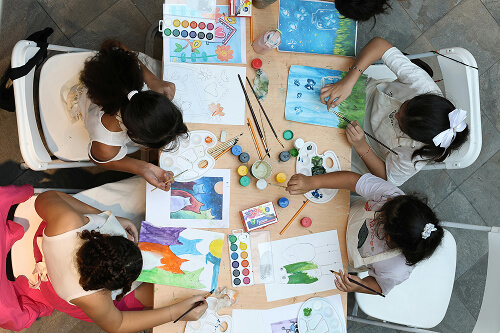
Creativity is crucial skill for children's future, but modern life often structures away opportunities for creative development. In 2025, research emphasizes unstructured play and boredom's role in fostering imagination.
Boredom sparks creativity. When children complain of boredom, resist immediate entertainment. Boredom discomfort motivates imagination. Children invent games, create stories, and discover interests when not constantly entertained.
Unstructured play time is essential. Free play without adult direction develops problem-solving and imagination. Building forts, creating imaginary worlds, making up games — this play builds crucial skills.
Art supplies should be accessible, not precious. Keep basic materials — paper, crayons, markers, clay — available for spontaneous creation. Process matters more than product. Messy creativity is healthy creativity.
Limit overscheduling carefully. While activities have value, children need downtime. Constant structure prevents creative exploration. Balance organized activities with unstructured time.
Nature exposure enhances creativity. Outdoor play in natural settings stimulates imagination differently than artificial environments. Sticks become wands, rocks become treasures. Nature provides endless creative possibilities.
Open-ended toys beat single-purpose ones. Building blocks, dress-up clothes, art supplies enable infinite uses. Toys doing everything for children limit creative thinking.
Reading aloud builds imagination. Stories expose children to possibilities beyond their experience. Visualization while listening develops mental imagery skills. Reading sparks creative ideas and language development.
Music exposure benefits creativity broadly. Learning instruments, singing, or simply listening to diverse music styles enhances pattern recognition and expression. Music connects to mathematical and linguistic creativity.
Cooking together teaches creative problem-solving. Following recipes develops sequencing skills. Adapting recipes encourages experimentation. Kitchen creativity produces tangible, delicious results.
Writing and storytelling deserve encouragement. Keep journals, create comics, make up stories together. Creative writing develops narrative thinking and self-expression. Don't critique — support the creative process.
Building and tinkering develop spatial reasoning. LEGOs, cardboard boxes, recycled materials — constructing anything exercises creative engineering. Taking things apart safely teaches how things work.
Dramatic play gets overlooked as children age. Pretend play isn't just for toddlers. Older children benefit from imaginary scenarios, role-playing, and creative performance.
Questions matter more than answers. Instead of providing solutions, ask: "What do you think?" "How could we try that?" "What would happen if?" Questions promote creative thinking.
Mistakes are learning opportunities. Fear of failure kills creativity. Emphasize that errors lead to discovery. Edison's light bulb failures were steps to success. Reframe mistakes as experiments.
Praise process over product. "You worked so hard on that" beats "You're so talented." Process praise encourages effort and experimentation. Product praise creates fear of imperfection.
Model creativity yourself. Let children see you trying new things, making mistakes, and creating. Creative parents raise creative children through example, not lectures.
Limit screen consumption in favor of screen creation. Making videos, editing photos, or coding are creative. Passively watching isn't. Shift toward productive screen use.
Schools often emphasize correct answers over creative thinking. Home can balance this by valuing questions without single answers, problems with multiple solutions, and exploration without judgment.
Creativity isn't reserved for arts. Math, science, and logical thinking involve creativity. Every field benefits from creative approaches. Foster creativity broadly, not just in traditionally creative domains.
The goal is raising adults who solve problems creatively, think independently, and find innovative solutions. Unstructured time, supportive environment, and freedom to explore cultivate lifelong creativity.
Our premium platform is currently unavailable for your connection in your current location.
See supported regions and mobile carriers for more information or when we plan to expand our service. Cost may apply.
Good news: You can still enjoy our trial content while we work on expanding!